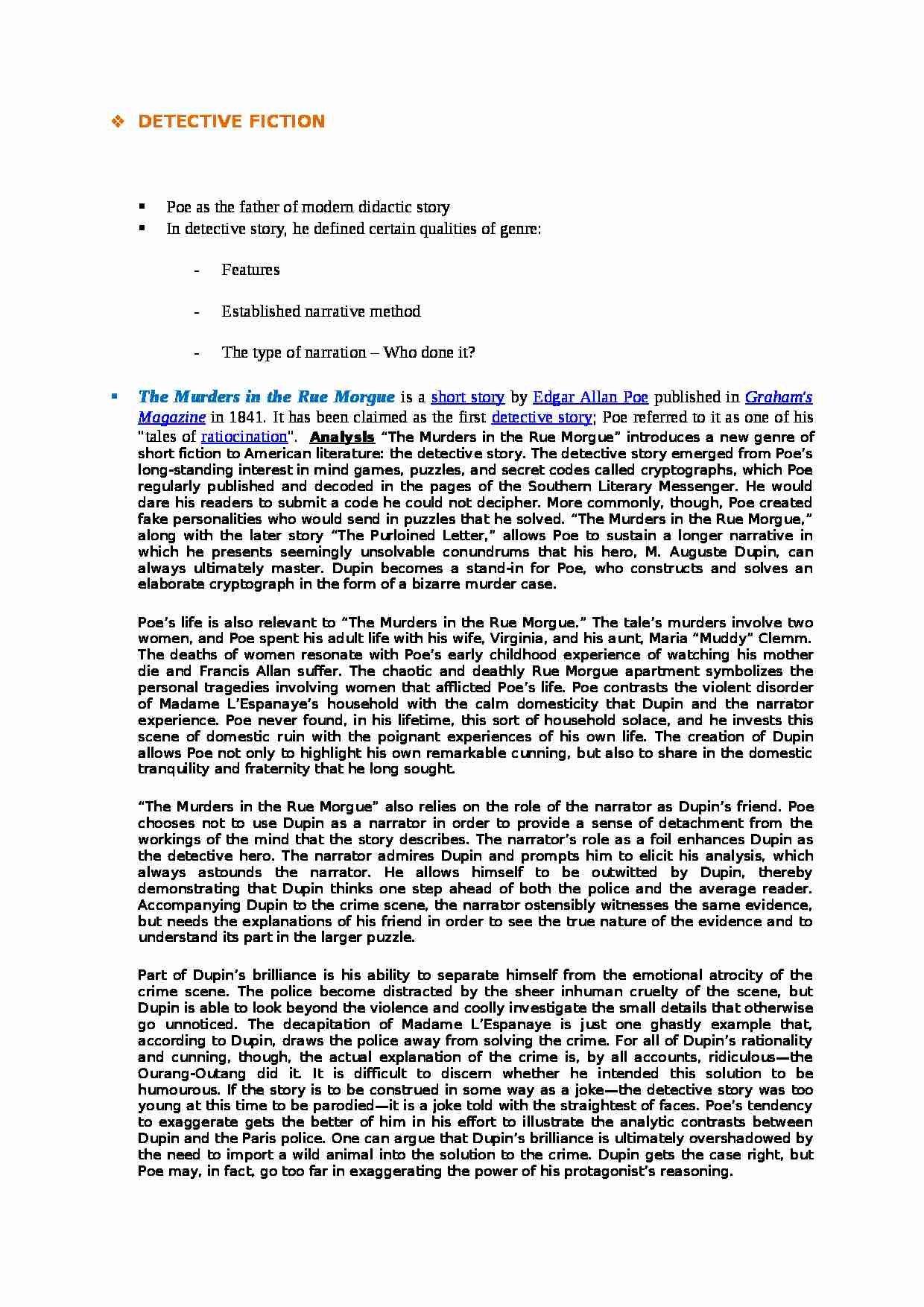To tylko jedna z 2 stron tej notatki. Zaloguj się aby zobaczyć ten dokument.
Zobacz
całą notatkę


Detective fiction
Poe as the father of modern didactic story
In detective story, he defined certain qualities of genre:
Features
Established narrative method
The type of narration - Who done it?
The Murders in the Rue Morgue is a short story by Edgar Allan Poe published in Graham's Magazine in 1841. It has been claimed as the first detective story; Poe referred to it as one of his "tales of ratiocination". Analysis “The Murders in the Rue Morgue” introduces a new genre of short fiction to American literature: the detective story. The detective story emerged from Poe's long-standing interest in mind games, puzzles, and secret codes called cryptographs, which Poe regularly published and decoded in the pages of the Southern Literary Messenger. He would dare his readers to submit a code he could not decipher. More commonly, though, Poe created fake personalities who would send in puzzles that he solved. “The Murders in the Rue Morgue,” along with the later story “The Purloined Letter,” allows Poe to sustain a longer narrative in which he presents seemingly unsolvable conundrums that his hero, M. Auguste Dupin, can always ultimately master. Dupin becomes a stand-in for Poe, who constructs and solves an elaborate cryptograph in the form of a bizarre murder case.
Poe's life is also relevant to “The Murders in the Rue Morgue.” The tale's murders involve two women, and Poe spent his adult life with his wife, Virginia, and his aunt, Maria “Muddy” Clemm. The deaths of women resonate with Poe's early childhood experience of watching his mother die and Francis Allan suffer. The chaotic and deathly Rue Morgue apartment symbolizes the personal tragedies involving women that afflicted Poe's life. Poe contrasts the violent disorder of Madame L'Espanaye's household with the calm domesticity that Dupin and the narrator experience. Poe never found, in his lifetime, this sort of household solace, and he invests this scene of domestic ruin with the poignant experiences of his own life. The creation of Dupin allows Poe not only to highlight his own remarkable cunning, but also to share in the domestic tranquility and fraternity that he long sought.
“The Murders in the Rue Morgue” also relies on the role of the narrator as Dupin's friend. Poe chooses not to use Dupin as a narrator in order to provide a sense of detachment from the workings of the mind that the story describes. The narrator's role as a foil enhances Dupin as the detective hero. The narrator admires Dupin and prompts him to elicit his analysis, which always astounds the narrator. He allows himself to be outwitted by Dupin, thereby demonstrating that Dupin thinks one step ahead of both the police and the average reader. Accompanying Dupin to the crime scene, the narrator ostensibly witnesses the same evidence, but needs the explanations of his friend in order to see the true nature of the evidence and to understand its part in the larger puzzle.
(…)
…—the detective story was too young at this time to be parodied—it is a joke told with the straightest of faces. Poe's tendency to exaggerate gets the better of him in his effort to illustrate the analytic contrasts between Dupin and the Paris police. One can argue that Dupin's brilliance is ultimately overshadowed by the need to import a wild animal into the solution to the crime. Dupin gets the case…
…, easily switches hoping he would get a lot of profit.
How to Write a Blackwood Article
a satirical "how-to" essay on formulaic horror stories typically printed in the Scottish Blackwood's Magazine and others. The term "article", in Poe's time, also commonly referred to short stories rather than just non-fiction. In this mock essay, Poe stresses the need for elevating sensations in writing. The sensations…
... zobacz całą notatkę




Komentarze użytkowników (0)